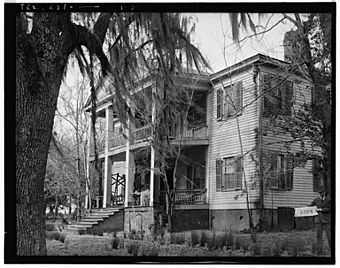Liendo Plantation facts for kids
|
Liendo Plantation
|
|

HABS image of Liendo Plantation
|
|
| Nearest city | Hempstead, Texas |
|---|---|
| Area | 9 acres (3.6 ha) |
| Built | 1853 |
| Architect | Leonard W. Groce |
| Architectural style | Greek Revival |
| NRHP reference No. | 71000970 |
Quick facts for kids Significant dates |
|
| Added to NRHP | June 21, 1971 |
Liendo Plantation is a very old and important cotton farm, or plantation, located in Waller County, Texas, United States. A plantation was a large farm where crops like cotton were grown, often using the labor of enslaved people.
The plantation is named after its first owner, José Justo Liendo. Later, in 1873, a famous sculptor named Elisabet Ney and her husband, a doctor named Edmund Montgomery, bought the property. Liendo Plantation is recognized as a special historical place in Texas and is also listed on the National Register of Historic Places, which means it's important to the history of the whole country.
Contents
History of Liendo Plantation
Early Days and Construction
The land where Liendo Plantation stands was first given to José Justo Liendo in 1828. At that time, this part of Texas was still part of Mexico.
In 1841, a man named Leonard Waller Groce bought the land. He turned it into a working cotton plantation. Groce also built the main plantation house in 1853, which is still there today.
Liendo During the Civil War
During the American Civil War (1861-1865), Liendo Plantation became a military site for the Confederate army. It was known as "Camp Groce."
A Training Camp
At first, Camp Groce was used as a training camp for new Confederate soldiers. Many soldiers came here to learn how to fight. However, the camp was in a place where many soldiers became sick. Sadly, some soldiers died from illnesses during this time.
A Prison Camp
Later in the war, Camp Groce was used as a prison camp for Union soldiers who had been captured. Hundreds of Union prisoners were held here. Like the Confederate soldiers, many prisoners also became very sick, and some died. Most of the soldiers who died at Camp Groce, both Confederate and Union, are still buried in the area.
After the War
After the Civil War ended in 1865, thousands of Confederate soldiers gathered near Hempstead, including at Liendo Plantation. They were waiting for the war to officially end in Texas.
Soon after, Union troops arrived in the area. Major General George A. Custer, a well-known Union cavalry leader, camped with his soldiers around Liendo Plantation for a few months. Their job was to help bring law and order back to Texas.
New Owners and Legacy
In 1873, the plantation was bought by German American sculptor Elisabet Ney and Scottish American scientist Edmund Montgomery. They were a married couple who had moved to Texas from Georgia.
Ney and Montgomery lived at Liendo Plantation for many years. Elisabet Ney became very famous for her sculptures. Both she and Edmund Montgomery are buried on the plantation grounds.
Recognizing its Importance
Liendo Plantation has been recognized for its historical value.
- In 1936, the plantation home received a state historical marker.
- In 1964, the entire plantation was named a Recorded Texas Historic Landmark.
- On June 21, 1971, Liendo Plantation was added to the National Register of Historic Places. These honors show how important Liendo Plantation is to the history of Texas and the United States.



